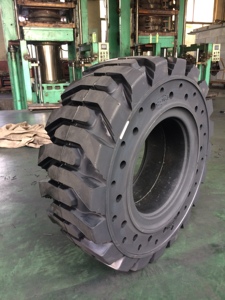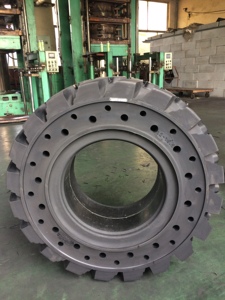Types of Skidder Tires
Skidder tires are crucial components in logging operations. Timber harvesters depend on their stability and strength to navigate difficult terrain while extracting timber. Their unique design and robust construction make them ideal for challenging off-road applications, available in various sizes and configurations to suit specific operational needs.
Expert Insight: Quality skidder tires can significantly impact productivity and fuel efficiency in logging operations. Investing in the right tire type for your specific terrain conditions can reduce downtime and extend equipment lifespan.
Chains for Skid Steer Tires
Chains for skid steer tires significantly improve traction and stability in challenging conditions. Designed for easy attachment to existing tires, they provide enhanced grip on slippery or uneven terrain.
Best for: Construction, snow removal, and landscaping operations in difficult conditions
Forestry Tires
Forestry tires are specially engineered for timber harvesting equipment. With unique tread patterns and robust construction, they provide excellent traction while minimizing environmental damage.
Best for: Rugged forest terrain and diverse weather conditions
Skid Steer Tires 10-Ply
These heavy-duty tires feature 10 layers of cord plies, offering enhanced load-bearing capacity and puncture resistance for demanding applications on challenging terrain.
Best for: Heavy-duty construction and industrial applications
Skid Steer Turf Tires
Designed with special rubber formulations and tread patterns that minimize ground disturbance, these tires are perfect for operations on delicate surfaces.
Best for: Landscaping, sports field maintenance, and turf-sensitive applications
| Tire Type | Key Features | Ideal Applications | Durability Rating |
|---|---|---|---|
| Chains for Skid Steer | Enhanced traction, multiple patterns available | Snow, ice, mud, slippery conditions | High |
| Forestry Tires | Cut-resistant compounds, deep treads | Logging, forest management | Very High |
| 10-Ply Skid Steer | Reinforced construction, puncture resistance | Construction, heavy material handling | Very High |
| Turf Tires | Low-impact tread, gentle ground contact | Landscaping, golf courses, athletic fields | Medium |
Specifications & Maintenance of Skidder Tires
Understanding skidder tire specifications is essential for selecting the right tires for your specific operational needs and ensuring optimal performance.
Tire Size
Example: 14-17
14" width on 17" rim
Tread Depth
Deeper = Better traction
Shallower = Longer wear on hard surfaces
Load Rating
Determines weight capacity
Must match skidder requirements
Speed Rating
Example: A8 = 8 km/h
B8 = 8.5 km/h
Key Specifications
Tire Size
Skidder tires come in various sizes suited for different skidder models. The first number indicates tire width in inches, while the second refers to rim diameter. Proper sizing affects ground clearance, stability, and performance.
Tread Design
Unique tread designs optimize off-road performance. Deeper treads provide better grip in muddy terrain but may wear faster on hard surfaces. Pattern variations address specific operational challenges.
Construction Type
Bias-Ply: Enhanced durability, load capacity, and puncture resistance for heavy logging.
Radial-Ply: Better traction, flexibility, and fuel efficiency for varied terrain.
Effective Maintenance Practices
Proper maintenance significantly extends tire lifespan and ensures optimal performance in challenging conditions.
| Maintenance Task | Frequency | Benefits | Consequences if Neglected |
|---|---|---|---|
| Tire Pressure Check | Daily/Weekly | Improved traction, reduced wear, better fuel efficiency | Uneven wear, reduced traction, potential blowouts |
| Visual Inspection | Before/After Each Shift | Early detection of damage, foreign objects removal | Punctures, cuts, catastrophic failure |
| Tire Rotation | Every 500-1000 hours | Even wear distribution, extended tire life | Premature tire replacement, uneven performance |
| Alignment Check | Quarterly | Prevents uneven wear, maintains optimal performance | Accelerated wear, reduced stability |
| Cleaning | Weekly | Prevents material buildup, allows better inspection | Hidden damage, accelerated deterioration |
Maintenance Tip: Keep a maintenance log for each tire, tracking pressure checks, rotations, and repairs. This data helps identify patterns and predict when replacements might be needed, allowing for better budget planning.
How to Choose Skidder Tires
Selecting the right skidder tires involves careful consideration of multiple factors to ensure optimal performance, safety, and cost-effectiveness for your specific operational needs.
Primary Selection Factors
- Ground Type: Match tire specifications to your primary operating terrain (soft soil, mud, rocky surfaces, etc.)
- Tire Size: Must comply with skidder model specifications for safety and performance
- Tread Pattern: Affects traction, stability, and ground impact
- Load Rating: Must exceed the combined weight of skidder and typical loads
Terrain Considerations
Assess your primary operating environment:
- Soft, muddy soil requires aggressive treads with self-cleaning properties
- Rocky terrain demands cut-resistant compounds and reinforced sidewalls
- Mixed conditions benefit from versatile tread patterns with moderate aggression
Operational Factors
Consider your specific logging activities:
- Heavy log extraction requires higher load ratings and durability
- Long travel distances benefit from tires with better heat dissipation
- Frequent direction changes need tires with excellent sidewall stability
Balancing Quality and Cost
| Factor | Economy Tires | Mid-Range Tires | Premium Tires |
|---|---|---|---|
| Initial Cost | Low | Moderate | High |
| Lifespan (hours) | 1,000-1,500 | 1,500-2,500 | 2,500-4,000+ |
| Puncture Resistance | Basic | Good | Excellent |
| Traction Performance | Acceptable | Good | Superior |
| Cost per Hour | Medium-High | Medium | Low-Medium |
Important: Never compromise on load rating specifications for your skidder. Underrated tires can fail catastrophically, causing equipment damage, operational delays, and potential safety hazards for operators.
DIY Skidder Tire Replacement Guide
Replacing skidder tires can be accomplished with proper preparation and the right equipment. Follow this step-by-step guide for a safe and effective tire change.
Preparation
Ensure you have the correct replacement tire size and type. Park the skidder on solid, level ground. Engage the parking brake and chock the wheels to prevent movement. Gather necessary tools: hydraulic jack rated for skidder weight, jack stands, lug wrench, torque wrench, and safety equipment.
Secure the Equipment
Position the hydraulic jack at the manufacturer-recommended lifting point nearest to the tire being replaced. Ensure all safety protocols are followed before lifting begins.
Remove the Old Tire
Loosen (but don't remove) the lug nuts while the tire is still on the ground. Raise the skidder with the jack until the tire clears the ground. Place jack stands under approved support points for safety. Fully remove the lug nuts and carefully take off the old tire.
Install the New Tire
Mount the new tire onto the wheel hub, aligning the holes with the wheel studs. Hand-tighten the lug nuts in a crisscross pattern to ensure even seating of the tire.
Secure and Finalize
Lower the skidder until the tire contacts the ground but doesn't bear full weight. Tighten the lug nuts in a star pattern to the manufacturer's specified torque. Completely lower the skidder and remove the jack and stands. Perform a final torque check on all lug nuts.
Safety Inspection
Verify the tire is properly seated and inflated to recommended pressure. Inspect for any obvious issues before returning the skidder to service. After a few hours of operation, re-check the lug nut torque.
Safety Reminder: Skidder tires are extremely heavy and can cause serious injury if mishandled. When possible, use mechanical assistance for moving tires, and never work under a skidder supported only by a hydraulic jack.
Questions and Answers
Radial tires feature flexible sidewalls that allow more sidewall movement, providing superior traction and reducing soil compaction. Their larger footprint better distributes weight across the ground surface. Radial construction also typically offers better heat dissipation and fuel efficiency during operation.
Bias-ply tires, with their stiffer sidewall construction, deliver enhanced durability and puncture resistance in extremely rugged or debris-filled terrain. They generally cost less than comparable radial options, making them economical for operations in particularly harsh environments where tire damage is common.
Skidder tire replacement intervals vary significantly based on operational conditions, maintenance practices, and tire quality. Typically, quality skidder tires last between 1,500 to 3,000 operating hours under normal conditions. However, several factors can affect this lifespan:
- Terrain type: Rocky or abrasive surfaces accelerate wear
- Operating techniques: Aggressive turns and rapid acceleration reduce tire life
- Load management: Consistently operating near maximum capacity shortens lifespan
- Maintenance practices: Regular rotation and pressure checks extend tire life
Regular inspection for cuts, unusual wear patterns, and tread depth is essential for determining the optimal replacement time before safety or performance is compromised.
While smaller mechanical equipment can theoretically manage skidder tire installations, specialized equipment is strongly recommended for safety and efficiency. Skidder tires typically weigh between 300-800 pounds (135-360 kg) each, presenting significant handling challenges.
For safer installations, professional logging equipment services typically use:
- Hydraulic tire manipulators specifically designed for large forestry tires
- Heavy-duty tire mounting machines with adequate capacity ratings
- Proper lifting equipment with sufficient weight ratings
If attempting installation with smaller equipment, ensure all components are properly rated for the weight involved, and always prioritize safety with additional personnel and proper lifting techniques.
Several common issues indicate the need for immediate skidder tire replacement:
| Issue | Description | Safety Risk |
|---|---|---|
| Severe Tread Wear | Tread depth worn beyond minimum safe operating levels | High - Loss of traction, especially in wet conditions |
| Sidewall Damage | Cuts, bulges, or cracks in the tire sidewall | Critical - Risk of sudden catastrophic failure |
| Significant Punctures | Penetrations exceeding repair limits or in critical tire areas | High - Progressive air loss and structural weakening |
| Tire Separation | Internal structure failure causing visible separation between components | Critical - Imminent failure risk during operation |
| Bead Damage | Rust, deformation, or damage to the tire bead area | High - Air seal compromised, mounting difficulties |
Regular inspection by qualified personnel helps identify these issues before they lead to operational failures or safety incidents.
The forestry equipment industry has been making progress toward more environmentally responsible tire options. While fully biodegradable skidder tires are not yet commercially viable, several manufacturers now offer more sustainable alternatives:
- Recycled material content: Some manufacturers incorporate reclaimed rubber in non-critical tire components
- Low rolling resistance compounds: These formulations reduce fuel consumption and associated emissions
- Extended-life designs: Longer-lasting tires reduce overall resource consumption and waste
- Retreading options: Some skidder tire designs can be retreaded, extending usable life and reducing waste
Additionally, many tire manufacturers now operate take-back programs where used tires can be properly recycled or repurposed rather than disposed of in landfills. When considering environmental impact, also evaluate a tire's operational efficiency, as fuel consumption during use represents a significant portion of its overall environmental footprint.




























































